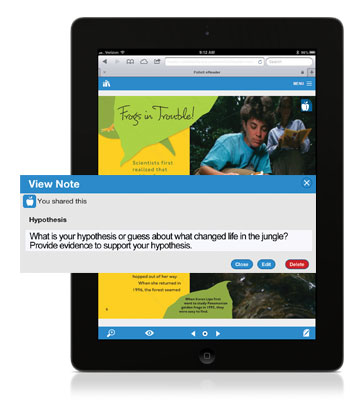
This is a sponsored guest post by Mitch Coulter, a former middle and high school science teacher who now works as Product Manager at Follett School Solutions. Mitch helps educators across the country learn how to integrate eBooks into instruction in order to meet Common Core State Standards and goals specific to the needs of individual schools and districts.
“Mark hasn’t read a single book all semester. Allison is always sneaking around on her phone texting or doing who knows what. I never have enough to keep Beth engaged and I know she’s bored as ever, and Andrew is always looking for someone to talk with about his homework assignments—students or teachers…”
This conversation, or one very similar, is one that I’ve encountered time and time again in talking with teachers. More students need more attention and one size never fits all. Differentiating instruction is a tough job, but giving students the tools to be successful has never been easy. There are a thousand different games, apps, and resources out there to satisfy their needs, but who has the time to learn all of them? Digital learning doesn’t have to be bells and whistles, animations and videos. . . in fact, some research indicates that when students are only passively engaged in content, they’re not really learning at all, but may revert back to the same mental patterns that they show when watching television.

Reading to learn has never been more important, and writing with skill and focus can open more doors than ever before. As for arithmetic, well, we all know that isn’t going anywhere any time soon. But in order to move forward into a brave new world of digital learning, we cannot forget the past, and at its heart are books. Reading and gaining a deep understanding of what is read is not exactly where Facebook posts, Tweets and dramatic headlines are taking us, but the essential skills of reading are the same. And so is learning to read for deeper understanding—close reading is more important than ever to better prepare students for what they will encounter in life.
Follett ebooks, paired with the Follett Shelf Classroom Connections, provide a unique opportunity to blend the new and the old, giving students the opportunity to engage with reading at a deeper level, while also building the skills they will need to be successful in today’s digital world. Classroom Connections is an add-on service to the free Follett Shelf platform. Classroom Connections offers instructional tools designed facilitate lesson-based interactions between teachers and students within Follett ebooks you select.
Imagine a reading scavenger hunt embedded directly into The Hunger Games, or giving a summative assessment question right next to the evidence students need to infer or evaluate and argument, all while getting immediate feedback directly into your own personalized ebook notebook. Embed a link to the State of the Union speech, or have students record his or her own voice reading the Gettysburg address.
What about giving a critical thinking writing assignment within an eBook to boost the rigor of The Cat in the Hat or the Berenstain Bears? What if you could assign a reading list customized to the needs of your struggling student Mark, or make Beth a reading group leader for your classics sections. It’s all possible.
The tools to catapult ebooks to the front of your curriculum are at your fingertips with Follett Classroom Connections. Visit Follett Shelf Classroom Connections to see how you can customize your students’ eBook reading experience, support close reading, focus learning on Common Core State Standards, and easily measure and monitor student reading progress.

Angela Watson
Founder and Writer
Sign up to get new Truth for Teachers articles in your inbox
OR

Join our
community
of educators
If you are a teacher who is interested in contributing to the Truth for Teachers website, please click here for more information.















